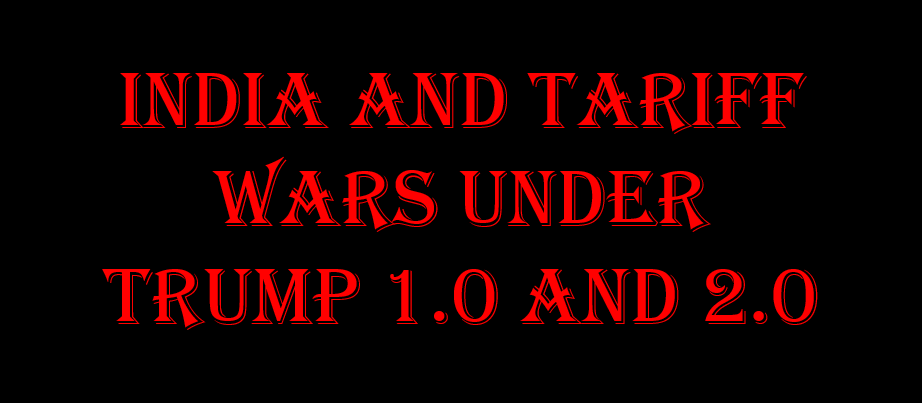
India and Tariff Wars under Trump1.0 and 2.0
by Dr H A C Prasad
During Trump 1.0, we did a major study in collaboration with India Exim Bank on ‘Relooking India’s Tariff Policy Framework’. Now Trump 2.0 presidency is seeing an ascendancy of tariff conflicts. Whether it will be of serious proportions, one has to wait and watch!
Since the US passing the Smoot-Hawley Tariff Act in 1930 raising import tariffs to protect American businesses from foreign competition which resulted in the Great Depression to the recent Tariff Conflicts/Wars under Trump 1.0 and Trump 2.0 ,there have been many trade/tariff wars and conflicts, like the US-EU chicken wars ,US-Europe Pasta war, etc.
Tariff Wars under Trump 1.0
In 2018/2019, the trade war between the US and China resulted in several rounds of retaliatory tariffs. As per an UNCTAD study, this led to fall in exports of both the countries of the tariffed products. This also had trade diversion effects , with Taiwan, Mexico, the EU, Vietnam and even India benefitting in their exports to the US of these items.
In 2018/2019, there was also trade conflict between the US and India. The simmering trade tensions between India and the US came to the open when two policies of the US triggered the Indo-US Tariff conflict. The first was the imposition of a global tariff on the US steel imports of 25% and additional tariffs on the US Aluminium imports of 10 % under section 232 of US Trade Expansion Act 1962.This was not exclusively against India and was directed on all countries. The second phase of Tariff Conflict between the US and India was more direct on India when GSP benefits were withdrawn from India on June 5,2019 automatically resulting in MFN tariffs for these items formerly under GSP in imports from India, It also triggered a 25% duty on solar cells which India was exempted from as long as it was a GSP beneficiary.
After multiple pauses, India imposed retaliatory tariffs on 28 items imported from the US, from June 2019.The main items in this list were Agricultural items like Almonds,Apple fresh,Iron and Steel and Chemicals. The US even took India out of Developing Countries’ list citing India’s share in World Trade above 0,5% and on account of India being a G-20 member. As a result , India was no longer eligible for special preferences under the methodology for CVD investigations, Our study shows that both the US and India were affected by these tariff measures
Tariff Wars under Trump 2.0
While a trade conflict between the US and India is in the offing , there are also efforts to resolve or reduce escalation of tariff wars.
Steps taken
Some steps were taken in India’s Budget 2025-26 which could facilitate India’s tariff negotiations with the US. The immediate impact making trade related measures in the Budget related to India’s Tariffs are the following.
The Way Ahead
There is a need to first fight the Perception War while undertaking tariff reforms to tackle the Tariff Wars. The US is repeatedly stating that India is a high tariff country and threatening countries including India with Reciprocal Tariffs.
India’s simple average applied MFN tariffs (as per WTO data) is 17.0% in 2023 and trade weighted average applied MFN tariffs is at 12.0 % in 2023. For Non-Agricultural sector it is 13.5% and 9.0% respectively and for Agricultural sector it is 39.0% and 65.0% respectively. Thus, India’s simple average MFN applied tariffs is not below 10% for Total and non-agricultural items and not below 30% for agricultural items. Thus, at first instance India’s tariffs seem to be relatively higher than many other countries including the ASEAN countries.
This however is not the real picture as around 69.2% of the tariff lines covering around 79.1 imports in the non-agricultural sector have less than 10% MFN applied tariffs in 2023. In the non-agricultural sector, import values and tariff lines are more concentrated in the lower end of the tariff range, while in the case of agricultural items they are more concentrated in the higher end of the tariff range.
Further, Effective tariffs taking into account India’s preferential tariffs to different countries, is much lower with simple average Effective tariffs at 8.7% and weighted average Effective tariffs at 4.9% in 2018 (as per TRAINS data). This shows that India’s import tariffs are not as high as it is believed to be.
If this be the case, then there is a need for India to dispel the belief that India is a high tariff country by highlighting these facts
Meanwhile , wherever possible MFN tariffs should be rationalized closer to effective tariff levels. While there is a need to bridge the gap between perception and reality, a careful rationalization of tariffs is also needed to bridge this gap between Realized Tariffs and MFN applied tariffs. But tariff rationalization has to be done cautiously as there are many sensitive items and items having livelihood concerns and Agriculture items are the ones which receive huge subsidies in the US, resulting in unfair competition with Indian Agricultural sector.
To begin with non-agricultural tariff lines with BCD above 10% should be examined for rationalization. Even items at the borderline of 10% can be considered for rationalization.
Thus, there is scope for rationalizing tariffs at least upto or near the Effective tariff levels. This can be done under the proposed Bilateral Agreement between the US and India (which was also suggested by us earlier).
Some important issues which need to be examined in the context of Tariff Wars
These are the following,